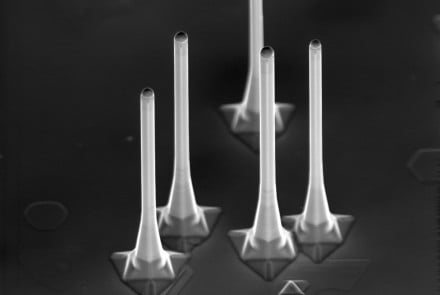This article is more than 1 year old
Nanowire laser is a GaAs, GaAs, GaAs (with a bit of arsenic)
Boffins demo room-temp nano-lasers to help marry optics and electronics
A group of researchers at the Australian National University (ANU) is showing off nanowire-based lasers, as part of the microelectronics world's ongoing search for the best way to integrate electronics and photonics.
The research, described in a Nature Photonics paper (abstract) led by Professor Chennupati Jagadish, demonstrates a process for growing gallium arsenide nanowires that act as lasers at room temperature.
Or, as the researchers put it in the abstract: “we demonstrate room-temperature lasing in core–shell–cap GaAs/AlGaAs/GaAs nanowires by properly designing the Fabry–Pérot cavity, optimising the material quality and minimising surface recombination”.
As many El Reg readers know, a conventional laser sets up a resonance in light by pumping a material to release light inside a mirrored cavity – and as ANU student Dhruv Saxena explains, even at small scales (like LED lasers), building lasers involves a number of processing steps.
In the ANU scheme, a GaAs-based nanowire captures light and reflect it along its axis. As the ANU release states, the GaAs also provides the amplification medium – and that means the entire laser can exist in a structure that's just a few billionths of a metre in diameter.

Nanowire lasers on substrate.
Source: ANU
Making the laser small is a step along the process of making it easy to integrate optics and electronics, an important goal in keeping Moore's Law rolling along: anywhere that light can replace electrons to communicate, a little bit of power (and therefore on-chip heat) is saved.
The other aspect of the work that ANU's pleased about is that it's a fairly straightforward manufacturing process. The nanowires are grown as crystals on a substrate scattered with gold particles that seed the growth.
“We provide gases containing gallium and arsenic and raise the temperature of the substrate up to 750°C. At these temperatures the elements react and nanowires start growing”, said Dr Sudha Mokkapati, who co-authored the paper with Saxena. ®
